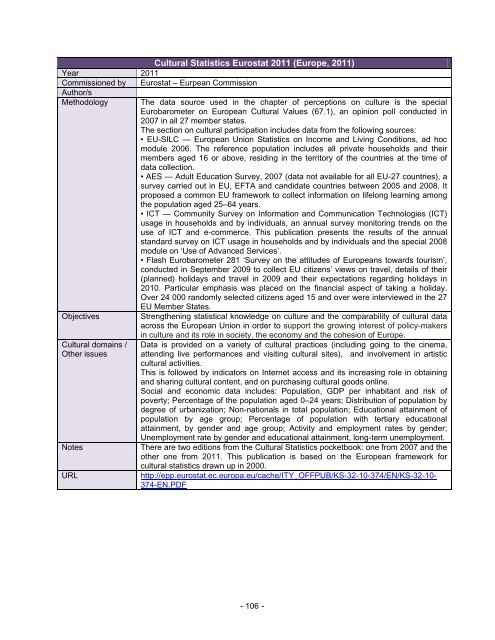gBDkI
gBDkI
gBDkI
Create successful ePaper yourself
Turn your PDF publications into a flip-book with our unique Google optimized e-Paper software.
Cultural Statistics Eurostat 2011 (Europe, 2011)<br />
Year 2011<br />
Commissioned by Eurostat – Eurpean Commission<br />
Author/s<br />
Methodology The data source used in the chapter of perceptions on culture is the special<br />
Eurobarometer on European Cultural Values (67.1), an opinion poll conducted in<br />
2007 in all 27 member states.<br />
The section on cultural participation includes data from the following sources:<br />
• EU-SILC — European Union Statistics on Income and Living Conditions, ad hoc<br />
module 2006. The reference population includes all private households and their<br />
members aged 16 or above, residing in the territory of the countries at the time of<br />
data collection.<br />
• AES — Adult Education Survey, 2007 (data not available for all EU-27 countries), a<br />
survey carried out in EU, EFTA and candidate countries between 2005 and 2008. It<br />
proposed a common EU framework to collect information on lifelong learning among<br />
the population aged 25–64 years.<br />
• ICT — Community Survey on Information and Communication Technologies (ICT)<br />
usage in households and by individuals, an annual survey monitoring trends on the<br />
use of ICT and e-commerce. This publication presents the results of the annual<br />
standard survey on ICT usage in households and by individuals and the special 2008<br />
module on ‘Use of Advanced Services’.<br />
• Flash Eurobarometer 281 ‘Survey on the attitudes of Europeans towards tourism’,<br />
conducted in September 2009 to collect EU citizens’ views on travel, details of their<br />
(planned) holidays and travel in 2009 and their expectations regarding holidays in<br />
2010. Particular emphasis was placed on the financial aspect of taking a holiday.<br />
Over 24 000 randomly selected citizens aged 15 and over were interviewed in the 27<br />
EU Member States.<br />
Objectives Strengthening statistical knowledge on culture and the comparability of cultural data<br />
across the European Union in order to support the growing interest of policy-makers<br />
Cultural domains /<br />
Other issues<br />
in culture and its role in society, the economy and the cohesion of Europe.<br />
Data is provided on a variety of cultural practices (including going to the cinema,<br />
attending live performances and visiting cultural sites), and involvement in artistic<br />
cultural activities.<br />
This is followed by indicators on Internet access and its increasing role in obtaining<br />
and sharing cultural content, and on purchasing cultural goods online.<br />
Social and economic data includes: Population, GDP per inhabitant and risk of<br />
poverty; Percentage of the population aged 0–24 years; Distribution of population by<br />
degree of urbanization; Non-nationals in total population; Educational attainment of<br />
population by age group; Percentage of population with tertiary educational<br />
attainment, by gender and age group; Activity and employment rates by gender;<br />
Unemployment rate by gender and educational attainment, long-term unemployment.<br />
Notes There are two editions from the Cultural Statistics pocketbook: one from 2007 and the<br />
other one from 2011. This publication is based on the European framework for<br />
cultural statistics drawn up in 2000.<br />
URL http://epp.eurostat.ec.europa.eu/cache/ITY_OFFPUB/KS-32-10-374/EN/KS-32-10-<br />
374-EN.PDF<br />
- 106 -


